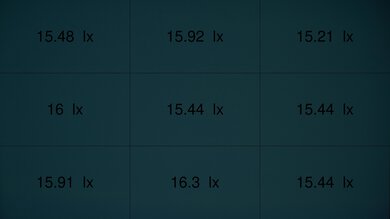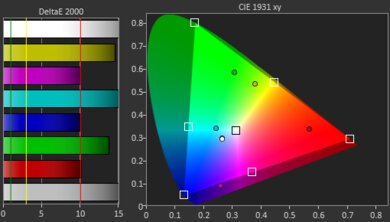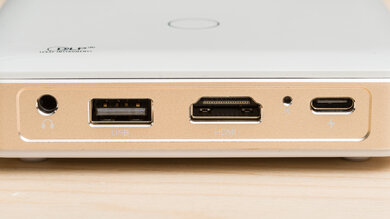The KODAK LUMA 150 is a very basic 480p portable pocket projector. It's designed to be small enough to fit in your pockets, and its integrated battery lets you take it with you easily. The LUMA 150 is capable of projecting images of up to 120". It's designed to quickly share media from your phone or mobile device over a wide selection of inputs, including USB, microSD, HDMI, or through the projector's mirroring capabilities via AirPlay or Miracast. It's Wi-Fi enabled and has a built-in 1.5W speaker.
Our Verdict
The KODAK LUMA 150 is bad for watching movies in a dark room. Its brightness is very bad, and it isn't usable in anything but the darkest of rooms. Unfortunately, it has terrible contrast, so fine details are hard to make out in dim scenes. It also has awful pre-calibration accuracy, and there's no way to calibrate it, so you're stuck with the terrible colors it comes with.
-
Extremely portable due to its size, Wi-Fi support, and integrated battery.
-
Very bad brightness; it's so dim you can barely see the image even in a dark room.
-
Terrible contrast, as everything is dark.
-
Awful color accuracy out-of-the-box and the projector doesn't have any calibration features.
-
Sub-par color gamut.
- 2.5 Movies
Changelog
- Updated Aug 02, 2024: We've converted this review to Test Bench 0.9. We've overhauled our Contrast tests, as we now measure contrast at various average pixel levels (APL). You can see the full changelog here.
- Updated May 23, 2024: Mentioned the newly-reviewed WiMiUS P63 in the Color Gamut section of this review.
- Updated Feb 28, 2024: Mentioned the newly reviewed KODAK LUMA 350 in the Contrast section of this review.
- Updated Feb 13, 2024: Review published.
Check Price
Differences Between Sizes And Variants
We bought and tested the KODAK LUMA 150 projector. It's one of the cheaper products in KODAK's LUMA range of projectors, which includes the cheaper KODAK LUMA 75 and the more expensive KODAK LUMA 350, KODAK LUMA 400, and KODAK LUMA 450.
| Model | Bluetooth | Resolution | Cast Capable | Wi-Fi |
|---|---|---|---|---|
| LUMA 75 | No | 360p | No | No |
| LUMA 150 | No | 480p | No | Yes |
| LUMA 350 | Yes | 480p | Yes | Yes |
| LUMA 400 | Yes | 720p | Yes | Yes |
| LUMA 450 | Yes | 1080p | Yes | Yes |
Compared To Other Projectors
This projector is terrible; we don't recommend buying it. However, it's extremely small and has an integrated battery, so it can be an extremely pocketable projector you can easily bring around. Still, if you need such a product, you'd be better off just going for the KODAK LUMA 350, which isn't great either, but it's certainly more usable than the LUMA 150. If you don't need the integrated battery, opt instead for the vastly better XGIMI MoGo 2.
Check out our recommendations for the best portable projectors and the best outdoor projectors. If you'd prefer to shop for another product in the same price range, look up the best projectors under $500 instead.
The KODAK LUMA 350 is better than the KODAK LUMA 150, and between the two, the 350 is the projector to get if you need an ultra-portable battery-equipped device. They both have awful color accuracy that you can't improve through calibration. However, the LUMA 350 is brighter, has better contrast, a wider color gamut, a slightly higher output resolution, Bluetooth support, and is cast capable through DLNA.
The KODAK LUMA 150 is better than the VANKYO Leisure 3, but only because the KODAK is much more portable due to its smaller size and integrated battery. When it comes to image quality, they're both equally abysmal.
The XGIMI Elfin is vastly better than the KODAK LUMA 150. The XGIMI does everything better, and while it isn't as portable as the KODAK, it's no slouch in that department due to its compact size and 2.2 lbs weight. The KODAK does have an integrated battery, but its image quality is so abysmal that it's hard to recommend it over the Elfin only for that feature.
The XGIMI MoGo 2 is much better than the KODAK LUMA 150. The KODAK has one advantage: portability. It's so small that you must see it to believe it, and it even comes with an integrated battery. Unfortunately, that extreme portability comes at a cost, as the KODAK's image quality is abysmal, with terrible brightness and poor contrast, as well as some of the worst pre-calibration accuracy possible, which you can't even improve through calibration.
The VANKYO Leisure 470 and the KODAK LUMA 150 are similar projectors. Both are very dim and have dull and inaccurate colors, but there are some differences. The Kodak is the better choice if you're after portability since it is a lot smaller, lighter, and is powered by an internal battery. On the other hand, the VANKYO has deeper blacks, thanks to its higher contrast ratio, so it looks better in a dark room. The VANKYO also has a higher native resolution, so its image is sharper than the Kodak.
The WiMiUS P63 is better than the KODAK LUMA 150, although the KODAK is much more portable because it's small enough to put in your pockets. The WiMiUS does have auto vertical keystone correction and a digital focus feature, both of which the KODAK lacks, so that helps when you want to move it around. The WiMiUS projects a sharper 1080p image than the KODAK's 480p, and it also has the better contrast of the two, on top of being a bit brighter. Finally, the WiMiUS has an integrated smart OS, while the KODAK doesn't.
Test Results
The KODAK LUMA 150 is extremely portable as it's surprisingly small and light, and it has an integrated battery and 1.5W speaker. Unfortunately, it doesn't have Auto Keystone correction or an autofocus, so it needs some manual adjustments for optimal image quality.
This projector has very bad brightness. It's barely usable, and the only way to see anything is to have absolutely no lights turned on in the room. At least it has outstanding brightness uniformity, so everything is equally dim.
This projector has terrible contrast. Blacks are deep, but that's mainly because everything is so dim. The KODAK LUMA 350 has much better contrast than this model.
The KODAK LUMA 150 has truly awful accuracy. The white balance and color accuracy are completely off, to the point that some colors show up as something completely different. The projector is extremely dark in all scenes, and its color temperature is extremely cold, giving everything a very noticeable blue tint.
The color gamut is sub-par. This projector can't display the full range of colors in SDR content and does a bad job with the wider Rec. 2020 color space. Consider the bigger yet still portable WiMiUS P63 if you want better contrast.
























